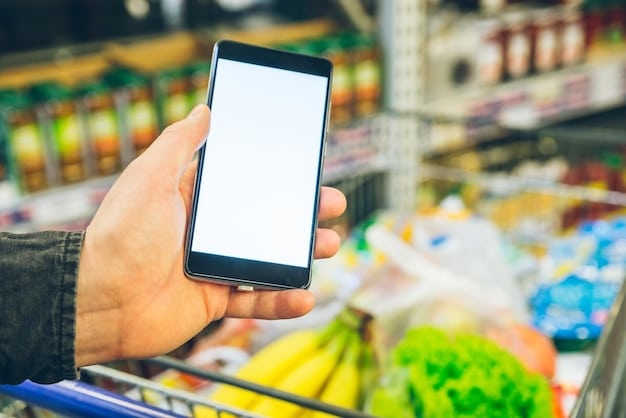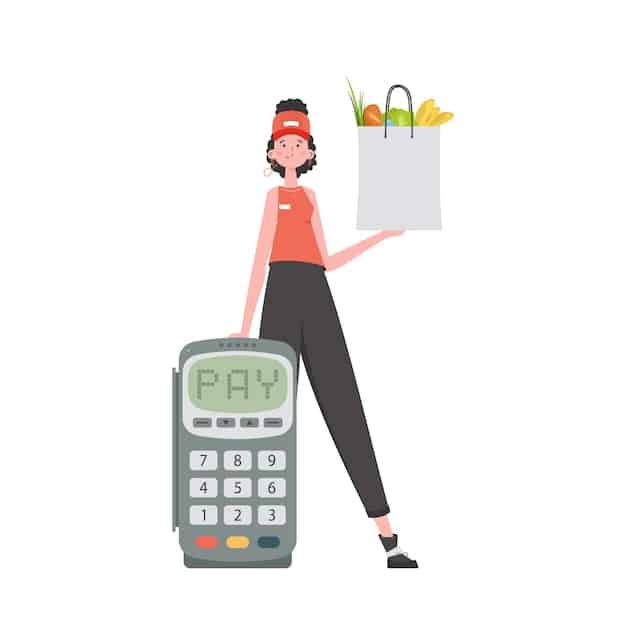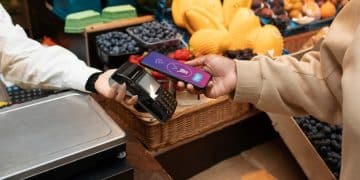Maximize Your Savings: Master Grocery Sales Cycles for Big Savings

Understanding grocery store sales cycles is essential for consumers looking to reduce their food expenses significantly, enabling strategic purchasing to capitalize on predictable price reductions and seasonal offers for optimal savings.
In today’s economy, making every dollar count is more important than ever, especially when it comes to essential expenses like groceries. Learning to **Maximize Your Savings: A Guide to Understanding Grocery Store Sales Cycles** offers a powerful strategy to significantly reduce your food budget. By understanding how and when stores discount products, you can transform your shopping habits from reactive spending to proactive, informed purchasing, ensuring you always get the best deals.
The Rationale Behind Grocery Store Sales Cycles
Grocery stores don’t just put items on sale randomly; there’s a sophisticated system at play. These cycles are meticulously planned to optimize inventory, drive foot traffic, and respond to consumer demand and seasonal trends. Understanding this underlying rationale is the first step toward becoming a savvy shopper.
One primary reason for sales cycles is inventory management. Retailers need to move products efficiently to make space for new stock, especially for perishable goods. Sales provide an effective mechanism to clear out older inventory before it expires or becomes outmoded.
Seasonal and Holiday Influences
Certain times of the year are predictably associated with specific types of products going on sale. Holidays, for instance, trigger promotional periods for related items. Knowing these patterns allows you to stock up strategically.
- Spring: Expect deals on baking essentials (for Easter), cleaning supplies, and barbecue items as the weather warms.
- Summer: Think grilling meats, picnic items, ice cream, and fresh produce common to the season, like berries and corn.
- Fall: Look for sales on baking ingredients for holiday pies, canned goods, and comfort foods as temperatures drop.
- Winter: Deals abound on holiday staples, hearty meal components, and health-related products post-New Year.
Beyond seasonal shifts, major holidays like Thanksgiving, Christmas, and even minor ones like Memorial Day or July 4th, are prime times for specific product categories to be heavily discounted. Planning your bulk purchases around these events can lead to substantial savings.
Another driving factor for sales is competition. Grocery stores constantly monitor their competitors’ pricing strategies. If a competitor offers a deep discount on a popular item, other stores might follow suit to avoid losing customers. This competitive environment often works to the consumer’s advantage, creating price wars that result in lower prices across the board.
Merchandising strategies also play a crucial role. Stores often use popular “loss leader” items—products sold at or below cost—to attract customers, hoping they will purchase higher-margin items once inside. These loss leaders are frequently part of a rotating sales cycle. Recognizing these patterns and leveraging them for your main purchases can significantly contribute to your overall savings. Learning to differentiate between genuine deals and everyday price fluctuations requires observation and practice, but the payoff is considerable.
Deciphering the Weekly Ad: Your Savings Blueprint
The weekly grocery ad is arguably your most powerful tool for savings. It’s not just a collection of random deals; it’s a carefully curated roadmap to the week’s best prices. Learning to read and interpret it effectively is fundamental to maximizing your savings.
Most grocery stores release their new ads on Wednesday or Thursday, valid for one week. These ads typically highlight loss leaders, seasonal specials, and brand promotions. Pay close attention to items grouped together, as they often indicate a meal theme or complementary products on sale.
Key Elements to Look For
Don’t just glance at the pictures and prices. Delve deeper into the ad’s specifics to uncover true value.
- “Buy One Get One Free” (BOGO) offers: These can be excellent deals if you use both items before expiration. Calculate the per-unit cost to ensure it’s genuinely a good price.
- Unit Pricing: Look for the smaller print showing the price per ounce, pound, or count. This is the most accurate way to compare different sizes or brands.
- Coupons: Many ads include store coupons or indicate manufacturer coupons that can be stacked with sale prices for even greater savings.
- Rain Checks: If an advertised item is out of stock, most stores offer a rain check, allowing you to purchase the item at the sale price once it’s back in stock. Always ask for one.
Beyond simply noting what’s on sale, start to recognize patterns in the weekly ad itself. Does your favorite brand of coffee go on sale every six weeks? Do paper products cycle through a deep discount every two months? Over time, you’ll develop an intuitive understanding of these cycles, allowing you to predict future sales and stock up during peak discount periods.
It’s also beneficial to compare weekly ads from different stores in your area. While it might seem time-consuming, a quick glance online can reveal which store has the best deal on your most frequently purchased items. This multi-store approach, often called “cherry-picking,” ensures you’re always getting the lowest prices on key staples.
Finally, utilize digital versions of weekly ads. Many stores offer their ads through apps or websites, which often include digital coupons that can be loaded directly onto your loyalty card. This not only saves paper but also simplifies the couponing process, making it easier to stack discounts and maximize your savings effortlessly.
Understanding Price Matching and Loyalty Programs
Two often-underutilized strategies for maximizing grocery savings are price matching and leveraging loyalty programs. Both require a little planning but can yield significant benefits over time, making your shopping trips more efficient and cost-effective.
The Power of Price Matching
Price matching policies vary widely by store, but when available, they can be a game-changer. Price matching allows you to buy an item at one store for the lower price advertised by a competitor. This means you don’t have to drive to multiple stores to get the best deals; you can consolidate your shopping.
- Check Store Policies: Before relying on price matching, always check your local store’s specific policy. Some might match only printed ads, others digital, and some might exclude certain items.
- Bring Proof: Always come prepared with the competitor’s ad (digital or physical) showing the lower price.
- Exclusions: Be aware that some items, especially generics or specific brands, might be excluded from price matching.
Successfully integrating price matching into your shopping routine can significantly reduce your overall grocery bill by ensuring you never pay more than necessary for essential items. It transforms shopping into a more strategic endeavor rather than a mere list-checking exercise.

Leveraging Loyalty Programs
Almost every major grocery chain offers a loyalty program, typically linked to a store card or phone number. These programs are designed to incentivize repeat business, but their true value lies in the personalized discounts and exclusive offers they provide.
Loyalty programs often offer members-only pricing, early access to sales, and points that can be redeemed for future savings or gas discounts. The key is to truly leverage these programs, not just passively participate.
- Sign Up for Everything: Join every loyalty program offered by the stores you frequent. It costs nothing and opens the door to potential savings.
- Customize Offers: Many programs offer personalized digital coupons based on your purchase history. Actively choose and load these coupons onto your card before shopping.
- Email Alerts: Opt-in for email notifications. Stores often send out exclusive deals, bonus points opportunities, and early previews of weekly ads to their loyalty members.
By combining the strategic use of price matching with the consistent application of loyalty program benefits, shoppers can build a powerful defense against rising grocery costs. It’s about being an active participant in the savings ecosystem, rather than a passive consumer. This proactive approach ensures that every shopping trip is optimized for maximum value, turning what often feels like a necessary expense into a rewarding exercise in financial management.
Stocking Up Strategically: The Art of Pantry Planning
One of the most effective ways to capitalize on grocery sales cycles is through strategic stocking up, commonly known as pantry planning or “stockpiling.” This doesn’t mean hoarding, but rather purchasing enough of an item at its lowest price to last until the next sale cycle. This requires both space and disciplined planning.
The core principle is simple: buy extra of non-perishable items when they are at their absolute lowest price. This ensures you never have to pay full price for staples you use regularly. Consider shelf-stable items, freezer-friendly goods, and household products. The savings accumulate significantly over time.
What to Stock Up On
Not all items are suitable for stockpiling. Focus on those with a long shelf life and consistent use in your household.
- Pantry Staples: Canned goods (beans, tomatoes, tuna), pasta, rice, flour, sugar, coffee, tea, olive oil, spices, and dried fruits.
- Frozen Goods: Meats (when on deep discount), vegetables, fruits, and frozen meals that freeze well.
- Household Essentials: Toilet paper, paper towels, cleaning supplies, soap, toothpaste, and laundry detergent.
- Personal Care Items: Shampoo, conditioner, skincare items, and first-aid supplies.
Before you start, take an inventory of your current pantry and freezer. What do you use regularly? What quantities do you typically go through? This assessment helps you determine how much of an item you realistically need to stock. Overbuying can lead to waste, negating any potential savings.
Create a dedicated space for your stockpile. This could be a pantry, a shelf in your basement, or a section of your garage. Proper organization is key to prevent items from expiring before you use them. Implement a “first-in, first-out” (FIFO) system, meaning newer purchases are placed behind older ones to ensure older items are used first.
Strategic stocking up also involves tracking prices. Keep a price book or use a spreadsheet to note the lowest prices you see for your frequently purchased items. This way, when a “stock-up price” appears, you’ll recognize it immediately and be prepared to buy. This meticulous approach ensures that your efforts translate into tangible financial benefits, minimizing impulse purchases at higher prices.
Lastly, be patient. You don’t need to buy everything at once. Build your stockpile gradually, purchasing items only when they hit their cycle low. This prevents overwhelm and allows you to spread out your spending, making the most of every sale opportunity as it arises.
Digital Tools and Apps for the Modern Saver
In the digital age, maximizing grocery savings has become significantly easier with the advent of various apps and online tools. These resources empower you to track sales, manage coupons, and even compare prices on the go, transforming your smartphone into a powerful savings assistant.
From store-specific apps that house digital coupons and loyalty card information to generalized platforms that aggregate deals from multiple retailers, the landscape of digital savings tools is rich and varied. Embracing these technologies can streamline your saving efforts and ensure you never miss a good deal.
Essential Digital Tools to Explore
There are numerous apps designed to help shoppers save money. Here are some categories and examples to consider.
- Store-Specific Apps: Most major grocery chains (e.g., Kroger, Target, Walmart) have their own apps. These are indispensable for loading digital coupons, checking weekly ads, managing loyalty points, and sometimes even ordering for pickup.
- Cash-Back Apps: Apps like Ibotta, Fetch Rewards, and Checkout 51 offer cash back on specific purchases, often in conjunction with existing sales or coupons. Simply scan your receipt, and earn money back.
- Price Comparison Apps: While less common for groceries specifically, some apps allow you to scan barcodes in-store to compare prices across different retailers, helping you find the absolute lowest price.
- Coupon Aggregators: Websites and apps like Coupons.com or RetailMeNot compile digital and printable coupons from various sources, making it easier to discover discounts for specific brands or products.
Leveraging these digital tools requires a habit of checking them regularly—before you shop and sometimes even while you’re in the aisle. Many apps offer push notifications for personalized deals or when items on your shopping list go on sale. Enabling these alerts can be a simple way to stay on top of savings opportunities without constant manual checking.

Another powerful digital strategy is to create and maintain a digital shopping list. Many grocery apps allow you to build lists that automatically highlight when an item from your list is on sale. Some can even organize your list by aisle, promoting efficient shopping and preventing impulse buys.
The goal is to integrate these tools seamlessly into your pre-shopping routine. Before heading to the store, take a few minutes to review the digital ad, load any relevant digital coupons, and check your cash-back apps. This small investment of time can yield significant returns, transforming your grocery trips from a chore into a highly efficient savings mission orchestrated by your smartphone.
Advanced Strategies: Stacking and Batch Cooking
Once you’ve mastered the basics of deciphering sales cycles and using digital tools, you can move on to more advanced savings strategies like “stacking” and “batch cooking.” These techniques elevate your grocery game, turning good deals into phenomenal savings and drastically cutting down on food waste.
The Art of Stacking Savings
Stacking refers to the practice of combining multiple discounts on a single item. This typically involves combining a manufacturer’s coupon with a store sale price, and sometimes even adding a cash-back app rebate on top. When done correctly, you can often get items for pennies on the dollar, or even for free.
- Manufacturer Coupons + Store Sales: This is the most common form of stacking. Find a manufacturer coupon for an item that is already on sale at your local grocery store.
- Digital Coupons + Paper Coupons: Some stores allow you to use a digital coupon (loaded to your loyalty card) in conjunction with a physical paper coupon for the same item. Research your store’s specific policy.
- Loyalty Program Offers + Discounts: Look for personalized offers through your loyalty program that can be combined with current sales or other coupons.
Effective stacking requires organization and a good understanding of your store’s coupon policies. Keep your coupons organized, either digitally or physically, and review them against the weekly ad before each shopping trip. The effort pays off by dramatically slashing the cost of frequently purchased items.
Batch Cooking for Efficiency and Economy
Batch cooking isn’t directly a shopping strategy, but it’s a powerful complementary technique for maximizing your grocery savings. It involves preparing large quantities of certain meal components or entire meals in advance, often using ingredients purchased on sale. This reduces waste, saves time, and prevents expensive last-minute takeout or restaurant meals.
- Capitalize on Sales: When meat or vegetables are on deep discount, buy in bulk and use them to cook larger portions. For example, if chicken breasts are on sale, cook a large batch and use them for salads, sandwiches, and stir-fries throughout the week.
- Reduce Food Waste: By planning meals around sale items and cooking them in advance, you’re less likely to let fresh produce or perishable items go bad before you can use them.
- Save Time and Money: Having pre-cooked components ready throughout the week means faster meal preparation, which in turn reduces the temptation to order expensive takeout after a long day.
Batch cooking not only saves money on the groceries themselves but also contributes to overall budget management by minimizing food waste and reducing reliance on costly dining out. It’s a holistic approach to grocery savings, ensuring that the valuable items you purchase at a discount are utilized to their fullest potential. This combination of savvy purchasing and smart preparation ultimately leads to a more efficient and economical household.
| Key Strategy | Brief Description |
|---|---|
| 🛒 Understand Sales Cycles | Identify predictable patterns in grocery discounts to buy at optimal prices. |
| 📰 Decode Weekly Ads | Utilize ads to find loss leaders, unit pricing, and coupon opportunities. |
| 📱 Leverage Digital Tools | Use apps for digital coupons, cash back, and price comparison to enhance savings. |
| 🍽️ Strategic Stocking & Batch Cooking | Buy in bulk when prices are low and prepare meals efficiently to reduce waste. |
Frequently Asked Questions About Grocery Sales Cycles
▼
Grocery sales cycles typically occur in patterns ranging from 4 to 12 weeks, depending on the product category. Highly perishable items might have shorter, more frequent cycles, while non-perishables like paper goods or pantry staples may only hit their lowest price every few months. Observing your local store’s weekly ads over time will help you pinpoint these specific rhythms for items you commonly purchase.
▼
“Loss leaders” are popular products that grocery stores sell at a loss or extremely low margin to attract customers into the store. The goal is that once inside, shoppers will also purchase other, higher-profit items. These items are often prominently featured in weekly ads and are excellent opportunities to stock up if they align with your needs.
▼
Whether price matching is worth it depends on your specific shopping habits and the store’s policy. If you buy many items that are cheaper elsewhere, price matching can save you significant time and gas by allowing you to shop at one location. However, if only a few items are cheaper, driving to the other store might be more efficient, especially if their non-sale prices are generally lower.
▼
To avoid overbuying, assess your household’s actual consumption rate before stocking up. Consider storage space, expiration dates, and how quickly your family uses a product. Aim to buy just enough to last until the item’s next anticipated sale cycle, rather than accumulating excessive quantities that might lead to waste.
▼
It depends on the individual grocery store’s coupon policy. Some stores allow “coupon stacking,” where you can combine a manufacturer’s paper coupon with a store’s digital coupon for the same item. Others permit only one coupon per item. Always review your preferred store’s specific coupon guidelines to understand what combinations are allowed.
Conclusion
Mastering the art of understanding grocery store sales cycles isn’t just about saving a few dollars here and there; it’s about fundamentally transforming the way you approach your household budget. By meticulously planning your purchases, leveraging weekly ads, utilizing digital tools, and embracing strategies like strategic stocking and batch cooking, you gain significant control over one of your largest recurring expenses. This informed approach not only leads to substantial financial savings but also fosters a more efficient and less wasteful household, proving that a little knowledge and discipline can go a long way in achieving financial wellness.





